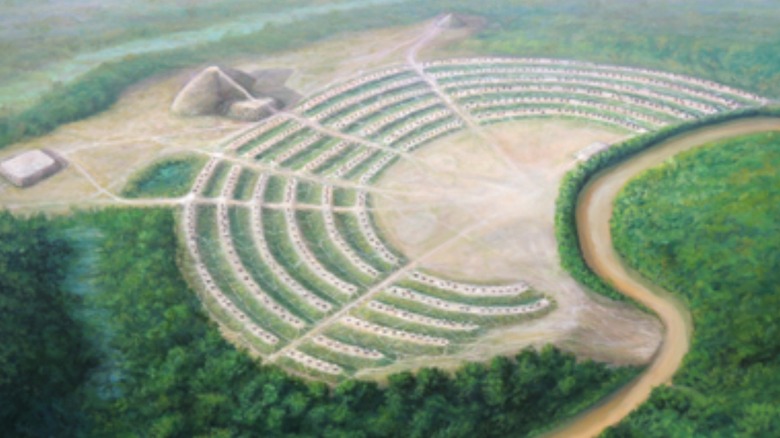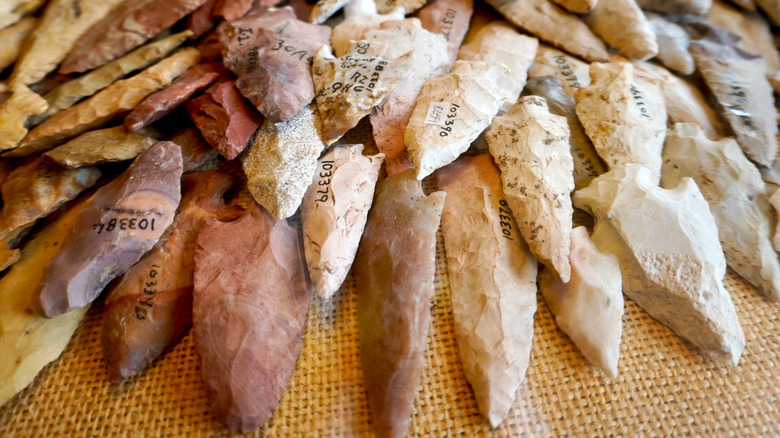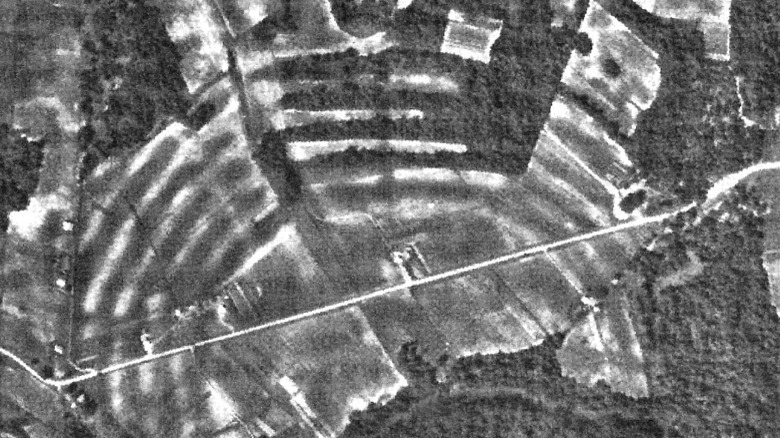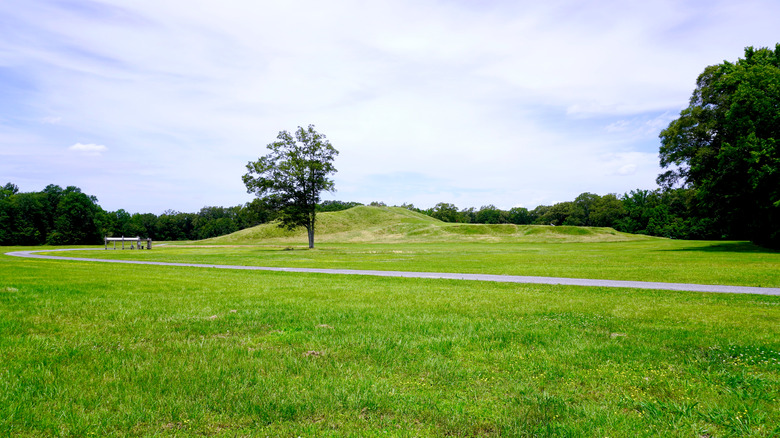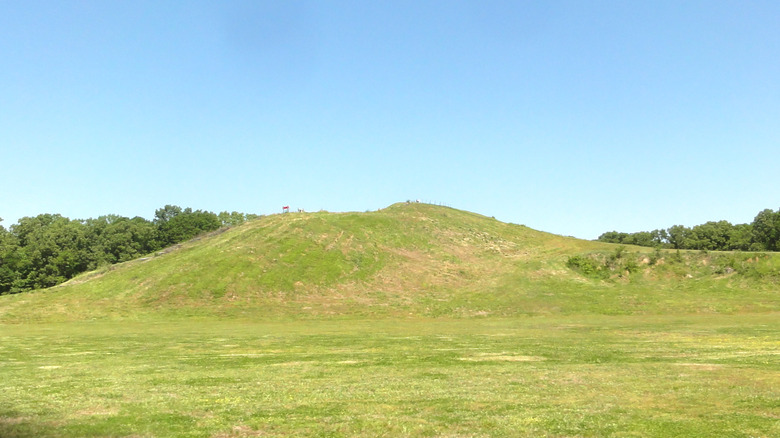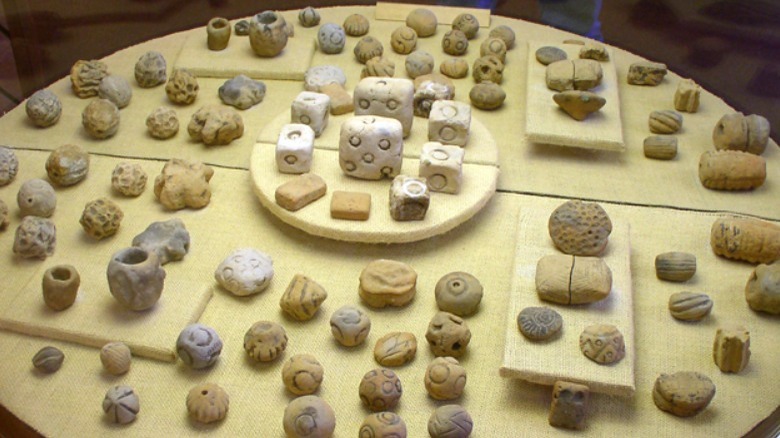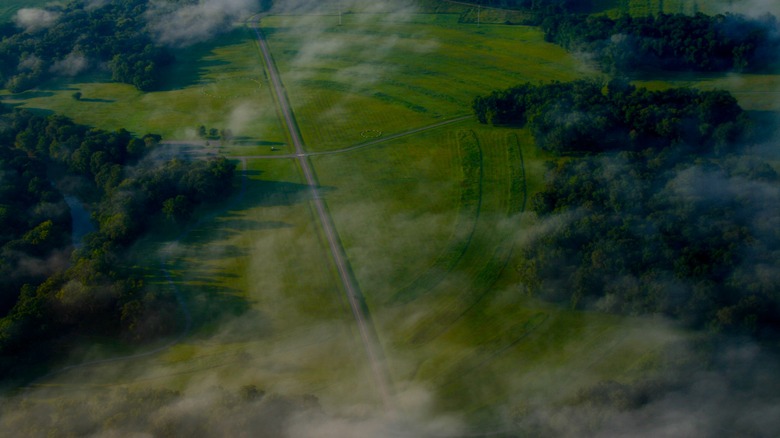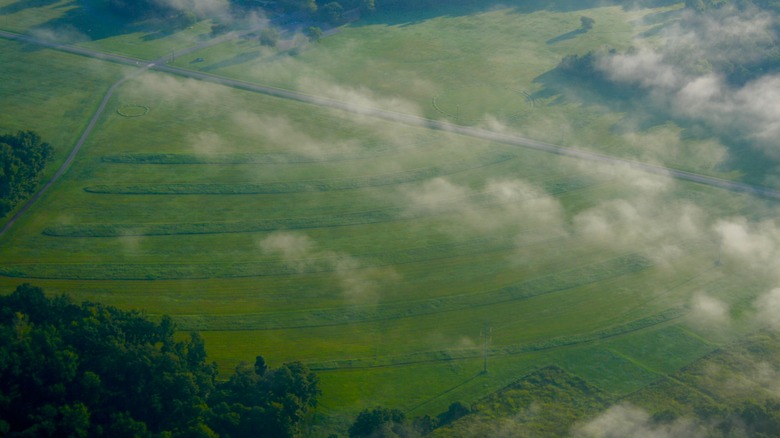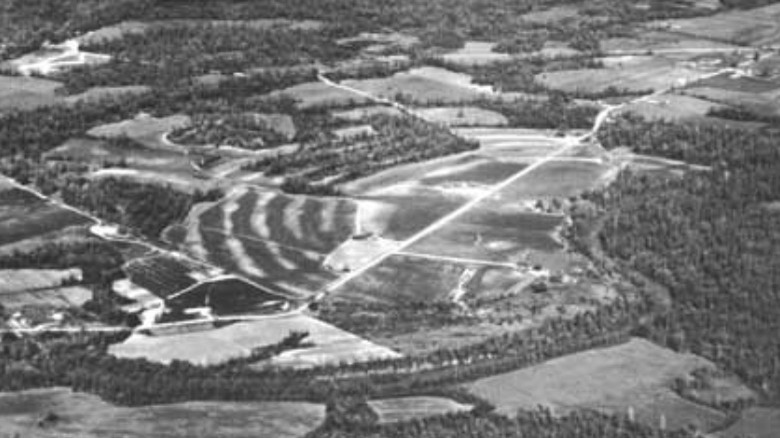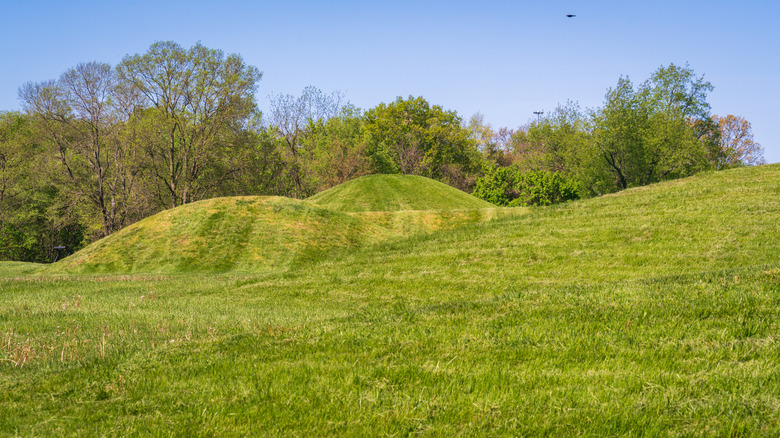What Was Poverty Point? We Explain
Despite being unfortunately named after a 19th-century plantation, the archeological site known as Poverty Point is actually a place of immense historical wealth, whose Indigenous creators have been described as "incredible engineers with very sophisticated technical knowledge." Many of the earthworks in North America were historically attributed by white American settlers to have been built by the Vikings, Welshmen, or Hindus, essentially anyone but the Indigenous population. And even when the earthworks were attributed to Indigenous people, they were underlined as a curiosity for "suggest[ing] that pre-agriculture, pre-ceramic hunting societies were more socially complex than previously thought," per The New York Times.
This assumption that non-agricultural societies aren't "complex" can be seen even in the archeological rhetoric used for Indigenous cultures on the North American continent. In doing so, not only is the history of these societies suppressed but the very knowledge of these cultures and societies is erased for the purpose of upholding a linear line of progress towards a single idea of "complexity." Even in 2021, archeologists continue to acknowledge that "we as a research community—and population as a whole—have undervalued native people."
The Monumental Earthworks at Poverty Point have yet to become household names like the Pyramids of Giza or the Sphinx and have never been declared a wonder of the world, but maybe in the 21st century, they'll be recognized as just one aspect of a fantastically intricate and complex history. What was Poverty Point? We explain.
A brief history of the Archaic Period
The period of 7,000 years between the flooding of the Beringia land bridge, around 8000 BCE, and the spread of maize to parts of North America, around 1000 to 800 BCE, is known as the Archaic Period. The Archaic Period is also preceded by the Paleoindian Period, which lasted from 12000 BCE to 8000 BCE, and the Pre-Paleoindian Period, from 17000 BCE to 12000 BCE.
According to 64 Parishes, the Archaic period itself is split into the Early Archaic, the Middle Archaic, and the Late Archaic. And over the course of 7,000 years, the Indigenous groups of North America saw and experienced countless changes. One of the biggest shifts was the sea-level rise as the Ice Age ended. With coastlines revealing themselves from under glaciers and river flows stabilizing due to high sea levels, these new environments and food sources were incorporated into various cultures.
Poverty Point is believed to have been mainly built during the Late Archaic, which lasted from 2000 BCE to around 1000 to 800 BCE. But while it's considered today to be one of the most significant earthworks from the Archaic, other earthworks were also built during the Middle Archaic.
Naming the Archaic Period
Most of the names given to the time periods featuring Indigenous people in North America bear are oriented from a Euro-centric worldview. According to the South Carolina Department of Archives and History, the Archaic Period is followed by what's described as the Woodland Period, which lasted 4,000 years from 3000 BCE to 1000 CE, and the Mississippian Period, which lasted less than 600 years from 1000 CE to 1520.
Archeologists line up the end of the Mississippian Period with the spread of European colonizers and settlers in North America and describe this early period of colonization as the Exploratory Period, which lasted from 1520 to 1670. It's at this point that the Indigenous people of Turtle Island were finally allowed into the annals of history with what's known as the Historic Period, which is considered to last from 1670 to the present.
In "The Dawn of Everything," David Graeber and Gavid Wengrow note that the name Archaic Period "is really more of a chronological slap in the face." By referring to a period as literally archaic is to declare, "this is the period before anything particularly important was happening." Archeologists have declared that various others cultures have an "Archaic Period," like the Ancient Greeks, but few span seven millennia. And to name an archeological time "Historic" is to underline that nothing of historical concern happened beforehand. However, nothing is further from the truth.
What is Poverty Point?
The Monumental Earthworks at Poverty Point is a massive archeological site located in the Lower Mississippi Valley in northeast Louisiana. Known as "the largest and most complex geometrical earthwork" in North America, the Monumental Earthworks were constructed around 1600 BCE and the entire structure extended over 200 hectares, according to "The Dawn of Everything."
Made out of a series of earthen six C-shaped ridges and six mounds, the remains of the Monumental Earthworks "look like some sunken, gargantuan amphitheater." The National Park Service writes that each ridge was originally "about 150 feet wide and six feet high, arranged as six concentric semicircles which terminate at the edge of the Bayou Macon." There's also a "widespread presence of artifacts" at the site.
According to The Source, different types of soil were also mixed together "in a calculated recipe to make the structures stronger." As a result, the Monumental Earthworks have been resilient against erosion. As Phys.org notes, "these earthworks have held together for more than 3,000 years with no failure or major erosion." And when it comes to working with dirt, it's actually a lot harder to do than it might seem. It's estimated that between one to two million cubic meters of soil were moved around to create the Monumental Earthworks at Poverty Point. A UNESCO World Heritage Site, the layout of the Monumental Earthworks is also "unique to this site," compared to the other earthworks created in North America.
Building the mounds
The construction of the Monumental Earthworks was simultaneously very quick and very slow. Some of the mounds were built during the Middle Archaic, around 3900 BCE to 3600 BCE. And according to the Journal of Archeology, these mounds were later incorporated into what would become the Monumental Earthworks at Poverty Point. The Lower Jackson Mound and the Motley Mound are both mounds that date to the Middle Archaic.
Meanwhile, Bird Mound, which was built 2000 years later, is believed to have been built in three months, according to Science Daily. But while the construction of the Mound was done relatively quickly, the rest of the earthen ridges are believed to have been built "over several centuries." As Graeber and Wengrow note, "to construct the earthworks at Poverty Point ... must have taken enormous amounts of human labor and a strict regime of carefully planned-out work, but we still have little idea how that labor was organized." And News Star writes that even portions of the Monumental Earthworks that were previously thought to be natural by archeologists, like the West Plaza Rise, are now realized to be just as constructed as the rest of the Monumental Earthworks.
Although most of the construction occurred during the Late Archaic Period, "the final construction event of Mound D" occurred during the Mississippian Period, roughly around 1100 CE to 1150 CE. This means that altogether, Indigenous people were interacting with the Monumental Earthworks for almost 6,000 years.
Bird Mound
Bird Mound, also known as Mound A, is the largest mound, reaching almost 70 feet tall and measuring 700 by 800 at the base. According to the Journal of Archeology, the mound is often interpreted as representing a bird, but interpretations of the bird itself vary. Some Muscogee (Creek) people interpret it to be an owl, while some Choctaw people have interpreted the mound to be a hawk. "Today her wings seem tilted downward, as if landing. Of course, this could be due to erosion."
In The Story of Movement, Choctaw novelist LeAnne Howe writes that considering the form of the Bird Mound, "it seems likely that she's a bird of prey, like a red-tailed hawk." Howe goes on to describe the three-month creation of Bird Mound as a "narrative performance (intentionally mounded) that embodies the story of the red-tailed hawk from birth to first flight," since the total number of days needed for a red-tailed hawk to go "from mating to a fledgling leaving the nest" is also 90 days.
Heritage Daily also writes that in addition to being known as Bird Mound, the mound has also been called "Earth Island," which raises questions as to whether or not the Monumental Earthworks was created with astronomical intentions.
Who built Poverty Point?
The culture that created the Monumental Earthworks is unfortunately also named after the plantation that existed near the site during the 19th century and is known as the Poverty Point culture. The people who inhabited the lower Mississippi Valley are believed to have lived there between 1730 BCE to 1350 BCE. According to "The Dawn of Everything," "they were hunters, fishers, and foragers, exploiting a superabundance of wild resources," and living without the use of farming or writing. In addition, they were "highly skilled engineers," as seen by the Monumental Earthworks.
However, the early mounds of the Monumental Earthworks show that the Poverty Point culture wasn't the first group of people in the area, nor were they the first "to establish traditions of public architecture." 64 Parishes writes that the Poverty Point culture "developed a remarkable and extensive trade in high-quality stones." There have also been numerous artifacts found at the Monumental Earthworks made of loess and clay. In total, it's estimated that "some 78 tons of exotic stone were imported into Poverty Point."
Much of the life of the Poverty Point culture remains a mystery to archeologists because no skeletal remains or burial grounds have been found. It's possible that bones may have dissolved away since "bone preservation is poor in the loess that covers the main site," but it's also possible that archeologists simply haven't noticed them as they may be interred away from the mounds.
The life of the earthworks
Archeologists have several theories as to what the Monumental Earthworks at Poverty Point were used for. News Star writes that there's a lack of burial sites and "past research about a supposed house floor found at Poverty Point remains unclear and incomplete" so it's difficult to say whether or not people actually lived at the Monumental Earthworks.
In "The Dawn of Everything," Graeber and Wengrow write that despite this lack of residential structures, there have been "staggering quantities of lithic tools, weapons, vessels and lapidary ornaments" found at the Monumental Earthworks, which were brought to the Monumental Earthworks site from somewhere else because there is no stone at Poverty Point with which to make some of the artifacts found. And considering the size of the earthworks, it's possible that "thousands of people gather[ed] at the site at particular times of year, in numbers outstripping any historically known hunter-gatherer population."
In addition to the presence of trade of numerous objects including textiles and fabrics that have eroded away, it's possible that the Monumental Earthworks were used towards non-material goods. Some theories suggest that Monumental Earthworks were "expressions of sacred geometry, linked to calendar counts and the movement of celestial bodies" as seen by the name of Earth Island for one of the mounds. The Journal of Archeology notes that although these multiple interpretations exist, it cannot be denied that the Monumental Earthworks were "massive in scale and a center within regional exchange and travel networks."
The first city?
It's questionable whether or not the Monumental Earthworks at Poverty Point can be considered a city or not. The design of Poverty Point resembles other Neolithic settlements with its concentric ridges, like Nebelivka in Ukraine, which is described as one of the "world's first cities." However, there's little evidence to suggest that people actually maintained a residence at the Monumental Earthworks.
While some texts describe Poverty Point as a "forgotten city," others instead classify it as a "socially complex culture," per Newswise. However, this differentiation between simple and complex societies mostly comes out of an archeological search for hierarchy. If "no evidence [is] unearthed of centralized government or administration – or indeed, any form of ruling class ... these enormous settlements [have] all the hallmarks of what evolutionists would call a 'simple', not a 'complex' society," Graeber and Wengrow write. And yet, the Monumental Earthworks are acknowledged as a complex society due to its architectural accomplishments despite the lack of evidence for hierarchical social organization.
Some of the earliest and largest cities in history occur in Mesoamerica, and although a hierarchical top-down structure may not be necessary for the establishment of a city, the residence of a population at a specific location is considered to be a necessity for a site to be considered a city. As a result, it's difficult to say whether or not the Monumental Earthworks at Poverty Point were actually used by Indigenous groups as a city without any proof of residence settlements.
What happened to Poverty Point?
Exactly what happened to the Monumental Earthworks and the Indigenous people who created them remains unknown to archeologists. However, as the Journal of Archeology notes, there may not have been a traditional "end" as one might usually conceive. Because there's evidence to know that people returned to this point on numerous occasions throughout history, "these 'returns' demand rethinking narratives of site 'abandonment,' which teleologically presume the completed nature of mound sites." To describe a site as "abandoned" also disregards the Indigenous peoples' "continued presence within ancestral landscapes, or what Majica describes as a scientific realism that obscures lived Indigenous realities."
According to the World History Encyclopedia, which also happens to refer to the Monumental Earthworks at Poverty Point as a city, note that the population is believed to have declined and the Monumental Earthworks were "abandoned sometime before 500 BCE." However, considering that ceramics were discovered at the Monumental Earthworks from around 1100 CE to 1150 CE, this idea that the site was completely abandoned may be exaggerated.
Another theory that's been suggested is that changing coastlines and flooding may have caused Indigenous populations to relocate. And as Kenneth E Sassaman writes in "The Eastern Archaic, Historicized" that it's notable that Poverty Point "was not reestablished in a more secure place"
The first excavation
One of the first modern reports of the Monumental Earthworks at Poverty Point was by Jacob Walter, who traveled through the area in the 1830s. Walter reported the existence of the Monumental Earthworks, describing it as an "Indian Town," but had little interest in the site since he was looking for lead mines instead. As a result, the site continued to be largely ignored for another century.
World History Encyclopedia writes that the land was purchased in 1843 by Phillip Guier and by 1851 the plantation on the land was known as Poverty Point. Although Walter published his report about the Monumental Earthworks in 1973, by that point the Monumental Earthworks had been "extensively farmed for decades." There were some small-scale excavations in the 20th century, including those by archeologist C.B. Moore in 1913. However, they "failed to recognize the scope and complexity of the site."
According to PBS, the full scale of the Monumental Earthworks was discovered by accident after a 20-year-old aerial photograph taken of the Monumental Earthworks was uncovered in 1953. It was at this point that the Monumental Earthworks started to draw attention and were declared a National Monument and National Historic Landmark during the 1960s. In 2014, the Monumental Earthworks at Poverty Point were declared a UNESCO World Heritage Site.
Not even the oldest
Although the Monumental Earthworks at Poverty Point are considered to be the largest earthworks in North America, they're neither the oldest nor the only ones on the continent. According to the Louisiana Division of Archeology, other earthworks in North America include Watson Brake in Louisiana, the Hopewell Mound Group in Ohio, and Cahokia in Illinois.
The oldest known earthworks in North America are known as the Watson Brake earthworks. Built around 3500 BCE to around 2800 BCE, it's believed that the construction of the mounds of Watson Brake took "over 600 to 700 years" during the Middle Archaic, around the same time as the earliest mounds of the Monumental Earthworks of Poverty Point were built. 64 Parishes writes that Watson Brake was initially considered to be part of the Poverty Point culture and it wasn't until the 1990s "that the remarkable antiquity of Watson Brake, and twelve other Middle Archaic mound sites in Louisiana, was recognized."
As of February 2022, Indian Country Today writes that the Hopewell Ceremonial Earthworks in Ohio are also in the midst of a court battle to determine whether or not the earthworks will be recognized as a UNESCO World Heritage site. And while the Monumental Earthworks at Poverty Point are the largest, the Hopewell Ceremonial Earthworks are by no means less impressive. "If the Octagon were placed on its side, it would be taller than the pyramids in Giza."
